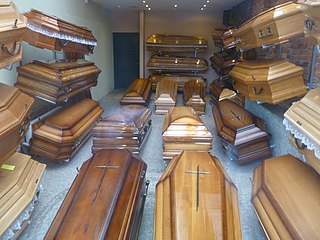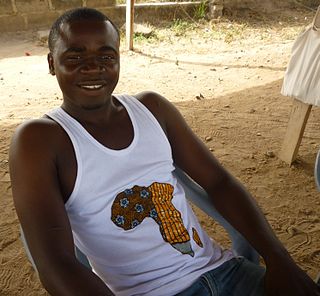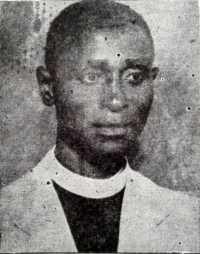
A coffin is a funerary box used for viewing or keeping a corpse, either for burial or cremation.
Guy Warren of Ghana, also known as Kofi Ghanaba, was a Ghanaian musician, best known as the inventor of Afro-jazz — "the reuniting of African-American jazz with its African roots" — and as a member of The Tempos, alongside E. T. Mensah. He also inspired musicians such as Fela Kuti. Warren's virtuosity on the African drums earned him the appellation "The Divine Drummer". At different stages of his life, he also worked as a journalist, DJ and broadcaster.
The Ga-Dangbe, Gã-Daŋbɛ, Ga-Dangme, or GaDangme are an ethnic group in Ghana, Togo and Benin. The Ga and Dangbe people are grouped respectively as part of the Ga–Dangme ethnolinguistic group. The Ga-Dangmes are one ethnic group that lives primarily in the Greater Accra of Ghana. Ethnic Ga family names (surnames) include Nikoi, Amon, Kotey, Kotie, Adei, Kutorkor, Oblitey, Lartey, Nortey, Aryee, Poku and Lamptey. The following are names derived from the ethnic Dangme and common among the Ningos Nartey, Tetteh, Kwei, Kweinor, Kwetey, Narteh, Narh, Dugbatey, Teye, Martey, Addo, Siaw, Saki, Amanor, Djangba. These are aligned to the ethnic Ga as well: Lomotey, Tetteh, Ankrah, Tetteyfio, Laryea, Ayitey, Okai, Bortey, Quaye, Quaynor, Ashong, Kotei, Sowah, Odoi, Ablor, Adjetey, Dodoo, Darku and Quartey.

The litter is a class of wheelless vehicles, a type of human-powered transport, for the transport of people. Smaller litters may take the form of open chairs or beds carried by two or more carriers, some being enclosed for protection from the elements. Larger litters, for example those of the Chinese emperors, may resemble small rooms upon a platform borne upon the shoulders of a dozen or more people. To most efficiently carry a litter, porters either place the carrying poles directly upon their shoulders or use a yoke to transfer the load from the carrying poles to the shoulders.

Teshie is a coastal town in the Ledzokuku Municipal District, a district in the Greater Accra Region of southeastern Ghana. Teshie is the ninth most populous settlement in Ghana, with a population of 171,875 people.
Articles related to Ghana include:
Owusu-Ankomah is a leading contemporary African artist with origins in Ghana. His work addresses themes of identity and the body, using his trademark motif of Adinkra symbolism. His work is also "influenced by the art of the Renaissance, handwritten texts from ancient cultures such as the adinkra symbol system of the Akan people of Ghana, Chinese ideograms, and contemporary global cultures." Owusu-Ankomah is a trained artist from Achimota college, near Accra, "established in 1936 and in 1952 incorporated into the University of Science and Technology at Kumasi."

Eric Adjetey Anang is a Ghanaian sculptor and fantasy coffin carpenter. He was born in Teshie, Ghana and runs the Kane Kwei Carpentry Workshop. He currently maintains dual residency and splits his time between Ghana and Madison, Wisconsin, where he is pursuing unique projects.

The Kane Kwei Carpentry Workshop is a studio established in Teshie, Ghana, since the 1950s. It is known for its design coffins that became symbolic of African artistic creativity. It featured the talents of several artists who would go on to gain fame as fantasy coffin sculptors, including Paa Joe, Kane Kwei, Eric Kwei, Cedi Kwei, and the lead of the shop at Kane Kwei's death, Theophilius Nii Anum Sowah.

Kudjoe Affutu is a Ghanaian artist and figurative coffin and palanquin builder. He was born and still lives in Awutu Bawyiase, Central Region, Ghana. Affutu has made a name for himself in Europe by participating in various art projects and exhibitions.

Ataa Oko Addo was a Ghanaian builder of figurative palanquins and figurative coffins, and at over 80 years of age he became a painter of Art Brut.

Fantasycoffins or figurative coffins, also called “FAVs” and custom, fantastic, or proverbial coffins, are functional coffins made by specialized carpenters in the Greater Accra Region of Ghana. These colorful objects, which developed out of figurative palanquins, are not only coffins but considered works of art. They were shown for the first time to a wider Western public in the exhibition Les Magiciens de la terre at the Musée National d'Art Moderne in Paris in 1989. The seven coffins shown in Paris were made by Kane Kwei (1922–1992) and his former assistant Paa Joe (b.1947). Since then, coffins by Kane Kwei, his grandson Eric Adjetey Anang, Paa Joe, Daniel Mensah, Kudjoe Affutu, Theophilus Nii Anum Sowah, Benezate, and other artists have been displayed in international art museums and galleries around the world.
Paa Joe is a Ghanaian figurative palanquin and fantasy coffin artist born 1947 at Akwapim in the Eastern Region of Ghana. Paa Joe is considered one of the most important Ghanaian coffin or abebuu adekai artists of his generation. He has been involved in the international art world since 1989, and has been included in major exhibitions in Europe, Japan, and the USA. His fantasy coffins are in the collections and on permanent display in many art museums worldwide, including the British Museum in London, the Brooklyn Museum in New York, The Royal Ontario museum in Canada ,Museum of fine Art in Boston ,the National Museum of Ethnology in Osaka and many others as well as the private collections of foreign dignitaries. paa Joe is building an Art academy and gallery to support the community and art students across the globe

Daniel Mensah, also known as Hello, is a Ga carpenter and fantasy coffin artist. He works as an independent artist and carpenter in Teshie, Greater Accra, Ghana.

A figurative palanquin connected with the totem of its owner is a special kind of litter used in the Greater Accra Region in Ghana. These palanquins called in the Ga language okadi akpakai belong to the royal insignias and are used only by the Ga kings or mantsemei and their sub-chiefs when they are carried in public at durbars and festivals like Homowo. With these figurative palanquins the Ga create ethnic differences between themselves and their Akan neighbours that only use simple boat- or chair-shaped litters.
Saâdane Afif is a French conceptual artist.

Carl Henry Clerk was a Ghanaian agricultural educationist, administrator, journalist, editor and church minister who was elected the fourth Synod Clerk of the Presbyterian Church of the Gold Coast, assuming the role of chief ecclesial officer of the national church from 1950 to 1954. Between 1960 and 1963, he was also the Editor of the Christian Messenger, established by the Basel Mission in 1883, as the newspaper of the Presbyterian Church of Ghana.

MatildaJohannaClerk was a medical pioneer and a science educator on the Gold Coast and later in Ghana as well as the second Ghanaian woman to become an orthodox medicine-trained physician. The first woman in Ghana and West Africa to attend graduate school and earn a postgraduate diploma, Clerk was also the first Ghanaian woman in any field to be awarded an academic merit scholarship for university education abroad. M. J. Clerk was the fourth West African woman to become a physician after Nigerians, Agnes Yewande Savage (1929), the first West African woman medical doctor and Elizabeth Abimbola Awoliyi (1938) in addition to Susan de Graft-Johnson, née Ofori-Atta (1947), Ghana's first woman physician. These pioneering physicians were all early advocates of maternal health, paediatric care and public health in the sub-region. For a long time after independence in 1957, Clerk and Ofori-Atta were the only two women doctors in Ghana. By breaking the glass ceiling in medicine and other institutional barriers to healthcare delivery, they were an inspiration to a generation of post-colonial Ghanaian and West African female doctors at a time the field was still a male monopoly and when the vast majority of women worldwide had very limited access to biomedicine and higher education. Pundits in the male-dominated medical community in that era described Matilda J. Clerk as "the beacon of emancipation of Ghanaian womanhood."
M. S. Bastian and Isabelle L. are a Swiss artist couple who have made a name for themselves with their comic art, including paintings, sculptures, animated films and installations.
A Ghanaian film poster is a film poster hand-painted in Ghana used to advertise films produced in Ghana as well as world cinema. Ghanaian film posters, particularly hand-painted posters from the 1980s and 1990s, have become noted for their imaginative and unique artistry. They have been exhibited around the world in galleries and museums in Los Angeles, New York, Hong Kong, San Francisco, Chicago, and across Europe.















